
TOPIC: What Is The Best Way To Break A Plateau?

The Question:
You've been working out for awhile now and your friends and family have really noticed your results. The results you were getting from your training kept coming and coming and your motivation was at an all time high... and then, like a stack of 45 pound plates crashing into the ground, your gains abruptly stopped.
Each week you would work out harder and harder, but each time you stepped on the scale with your eyes half closed, afraid to look, you were let down by the realization that after all of your hard work, you hadn't gained another ounce of muscle. Are you just wasting your time?
A plateau is one of the most frustrating things in bodybuilding, second only to an injury. Don't worry though, you are not alone. Almost everybody hits a plateau from time to time. Some people never get out of the slump and quit, but some people seem to get past it and start gaining again almost immediately. How do they do it?
What are the major causes of plateaus? What should you do if you hit a plateau? Is there a special "shock" training program that you can do? Should you be analyzing your workout, nutrition, and supplement programs to see what is wrong? Should you try something different with your training, nutrition and supplements? Should you take a break, and if so, for how long?
Give your full and detailed advice to help others around the world who are suffering from this dreadful condition!
Show off your knowledge to the world!
The Winners:
- bubba g View Profile
- antihero View Profile
- doggiejoe View Profile
Prizes:
1st place - 75 in store credit. 2nd place - 20 in store credit.- 3rd place - Free Bodybuilding.com hat.

1st Place - bubba g

 Plateau Busting!
Plateau Busting!
Anyone who has trained for any length of time knows what it's like. Everything is going great in your training, every week you are either adding weight or reps on all of your exercises. You're packing on muscle so fast you can see the difference from week to week.
Then when things couldn't be any better, out of no where BLAM! You hit a wall. You can't add weight to any of your exercises. You chalk it up as a bad week, and tell yourself next week you will be back on track. The next week comes and again you can't add more weight or get one more rep on anything.
It is like a bad dream only you can't wake up. Thankfully there are several things you can do to bust through your plateau. In this article I will discuss the many ways you can get back on track.
 Diagnosing The Problem
Diagnosing The Problem
 Diet
Diet
- When a plateau is reached often the diet is overlooked as the possible cause. The best way to remedy this is to recalculate everything to make sure that you're taking in enough of the three macronutrients protein, carbohydrates, and fats.
One mistake I see made all the time is when someone calculates their diet when they weigh 180lbs then they get up to 200lbs and never make adjustments for this extra 20 pounds.
That 20lbs difference increases your caloric needs by 300 calories. Make sure you are getting your calories from good healthy foods. Avoid junk foods, or fast foods that are loaded with saturated, and trans fats.
It is also a good idea to avoid sugars with the exception of your post workout shake. So forget about McDonalds or Burger King. In addition, I can't stress enough the importance of drinking lots of water as it helps your body utilize the food you eat and the vitamins and minerals you take. You should be drinking at least a gallon a day.
A 40/40/20 ratio of macronutrients is what I follow. I will do a sample breakdown for a 200lb man here. The first thing you want to do is multiply your body weight by 15 so for this example 15 X 200 = 3000. This is how many calories you will consume per day.
To find out how much protein you will need to figure out what 40% of 3000 is. You do this by multiplying .4 X 3000 = 1200 calories from protein. Carbs will also be 1200 calories for a total of 2400 which means the remaining 600 calories will be from fats.
Proteins and carbs are both 4 calories per gram, and fat is 9 calories per gram. so to break it down to how many grams of each are needed you simply divide the proteins and carbs by 4 and the fats by 9.
There you have it. It's as easy as that. One piece of equipment you cannot do without whether you're bulking, or cutting is a Food Scale.
Special Note: If you are following a cutting diet, and you are in a caloric deficit you can expect to not only halt progress in strength and mass gains you may also lose some of each. This is normal and not a plateau, so don't panic. Just do your best to lift as heavy as you can during this time.
 Same Old Routine
Same Old Routine
- Another common cause of a plateau is staying with the same routine for long periods of time. All too often I see this. People find their favorite exercises and they refuse to do anything else. This is the worst thing you can do.
One of the best ways to avoid hitting a plateau is to change your routine often. Every 6 to 8 weeks is optimal. Here are a few of the many ways you can change your routine.
That's right. Changing the number of reps per set is a good way to add variety to your routine. This can be done by using 12 reps per set for 1 week, 10 reps per set the next week, 8 the following week, and finally 6 reps per set on the 4th week.
At this point you can either climb back up the ladder and go back to 8 reps the next week, or you can jump back up to 12 reps a set and work your way back down. Another way of doing it is to can change your rep range from workout to workout.
Below is an example of a Mon, Wed, Fri, routine:
- Monday - 12 reps (reps per set)
- Wednesday - 10 reps
- Friday - 8 reps
- Monday - 6 reps
- Wednesday - 8 reps
- Friday - 10 reps
Another simple but effective technique to ward off the evil plateau is to change the order in which you perform your exercises. This can greatly decrease the chance of getting stuck. Again this can be done week to week or changed once every 6 to 8 weeks.
If you do chest and shoulders on Monday do the chest first one week and shoulders first the next week. If you do bench press first in your chest routine one week do it last the next week.
Remember it is important to keep your body guessing. A lot of people are hesitant to do this because when they move their bench press to the last exercise in the routine they can not lift as much. Nevertheless, in the long run it is much better because you will constantly improve, as opposed to hitting plateau after plateau.
Changing the time between your sets is one of the easiest things you can do to keep things from getting stale. The time between sets can vary from 30 seconds to 3 minutes for most movements, and up to 5 minutes for heavy compound exercises that are taxing on your CNS (central nervous system) like squats, and deadlifts.
Another easy and effective way to add variety to your routine and to keep your muscles guessing is to change the tempo at which you perform your reps. This changes the time the muscles are under tension (refers to how long your muscles are bearing a load).
These are broken into 3 parts:
- The negative or (eccentric) phase of the lift
- The pause at the bottom portion of the lift (represented by the middle number)
- And finally the positive or the (concentric) portion of the movement.
For hypertrophy it is best to have a time under tension of between 30 seconds and a minute. Rep range should be taken into consideration when determining tempo. For example if you are training in the 10 rep range you want your time under tension at 60 seconds (you know you must spend 6 seconds total per rep).
Some examples are:
- 4-0-2
- 3-2-1
- 4-1-1
- 2-2-2
- 3-1-2
The lower the number of reps in your sets the longer you are going to want to spend on each rep so you are sure to fall into the effective time under tension.
When you get down to 6 rep sets you will have to take 10 seconds per rep to have a time under tension of 60 seconds.
These sets are very grueling and I guarantee you will not use nearly as much weight as you are used to, but it is very effective at causing muscle hypertrophy.
This one should be obvious. Change all of the exercises you do for each body part. This not only prevents you from getting bored with your routine, it prevents you from hitting a plateau.
Most people don't like to stop doing their favorite movements especially after they have built up to using a good amount of weight on a particular one, but what they don't realize is that when they return to it they will almost certainly be much stronger on the movement.
If you are working out 3 days a week, switch to 4 days a week or 5. If you are doing chest and triceps on the same day now do them on separate days. The possibilities are endless. Use the Bodybuilding.com workout database to find a routine that is right for you.
Overtraining
Overtraining is one sure fire way to stop making gains, in fact if left unchecked it can actually decrease the size of your muscles and your strength. For many beginners overtraining is a vicious circle.
Their strength and mass gains come to a standstill, so what do they do? You guessed it they increase their workload assuming that more work is needed to remedy the problem. Which couldn't be further from the truth.
Overtraining occurs when you do not allow yourself enough time to heal in-between workouts. The time required between workouts to recover can vary depending on a few factors: genetics, nutrition, and sleep.
Here are a few symptoms that will help you diagnose weather or not you are overtrained:
If you are experiencing two or more of these symptoms and are not making gains, then it is fairly safe to say that you are in an overtrained state. Now that the problem has been diagnosed the best thing to do is to take two weeks off from all training.
I know I know it sucks but in the long run you will be so much better off, it's well worth it.
Often you will be stronger upon returning to the gym after the two weeks are up, and you will be extremely motivated because you will be dying to get back in the gym.
While you are taking that time off you can figure out how you got into an overtrained state by looking at your diet and your routine then make adjustments accordingly.
Make sure you are eating enough healthy foods, Only train each body part once a week, lower the volume of your training to 3 exercises per body part at 3 sets and you should be well on your way to making progress once again.
 |
||||
 |
|
 |
||
 |
||||
 Not Enough Sleep
Not Enough Sleep
- Lack of sleep alone can cause you to plateau. Your body recovers when you are sleeping. So poor sleep = poor recovery, and if you don't recover between workouts you will overtrain, simple as that.
So try to get at least 8 hours of solid sleep. 9 is even better. If you need to use an alarm clock to wake up, odds are that you are not getting enough, also if you are not sleeping through the night you are probably not getting enough REM or (stage 4 sleep).
It is when you are in this deep sleep that most of your recovery occurs. So if sleeping through the night is a problem then you might want to consider trying Melatonin, or Valarian root to help you.
 Increase Intensity
Increase Intensity
- If you're not using enough intensity in your workout then you might as well pick up your skirt and sprinkle some fairy dust around the gym. Sometimes the reason for a plateau is from not working out with enough intensity.
In that case what you need to shock your body back into growing. There are plenty of effective ways of doing this. I will list a few with brief descriptions here.
- Partial Reps:
Partials are completed by moving the weight in a limited range of motion. Usually the strongest part of the lift is used, for example the top six inches of the bench press, or the top twelve inches of the squat, rack pulls are a partial deadlift where you set the pins on a power rack so the bar is just below your knee caps when you begin the lift. All are great for adding intensity to your workout.Partials can also be done in your weakest part of the movement. This means squatting from the bottom position to half way up then back down again. Bench press would be from your chest to half way to top of movement then back to your chest again.
I would not recommend doing deadlifts in the weak range of motion which is from the floor. Stick to doing the rack pulls.
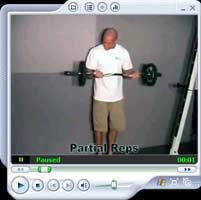 |
View The Video:
Choose your version:
|
- Negatives:
Negatives are performed by first loading up the bar with more weight than you can lift on your own, then having your training partner, or spotter help you lift the weight for the concentric part of the lift.The eccentric portion is done by you alone. Aim for 6 to 10 seconds per rep.
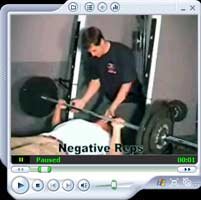 |
View The Video:
Choose your version:
|
- Stripsets:
Strip sets are done by loading up the bar with a heavy weight (after warm up) after you complete 8 reps or so and can not get one more rep at that weight you have people on either side of the bar strip off some weight, you get as many reps as you can at that weight and again weight is stripped.Do this till you are down to the bar. You might want to keep a bucket close by for this one. This can also be done with dumbbells.
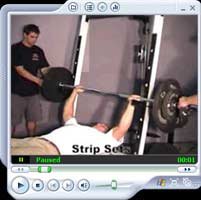 |
View The Video:
Choose your version:
|
- Supersets:
Supersets are done by completing two exercises usually for opposing muscle groups. For example you could do a set of skull crushers and as soon as you put down the bar pick up a barbell and begin doing biceps curls.You can do bent rows immediately followed by a set of bench press, etc.
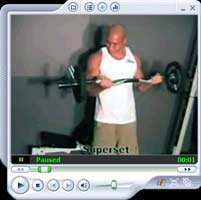 |
View The Video:
Choose your version:
|
- Giantsets:
Giant sets are almost the same as supersets except you use three exercises. - 100 Rep Sets:
These are not for the weak. Pain is definitely going to be involved here, and if you didn't know what lactic acid was before I promise you will after completing a 100 rep set.These are done by putting a much lower weight on the bar than you are used to (a weight you can get 50 reps with without stopping) and then cranking out 100 reps with that weight.
Once you fail, or succumb to the pain, stop and take a few deep breaths (try to keep it to 5 deep breaths), don't put the weight down while you take them. Then keep going until you hit 100 reps.
During this time you want to occasionally stop and take a few deep breaths. Once you get close to 100 you will probably be taking 5 breaths between every 3 reps... enjoy.
- Rest Pause:
Rest pause is simply where you take a weight that you can get say 10 reps with, complete the 10 reps., rack the weight, and then take 15 deep breaths. Then pick the bar up and do as many more as you can. Repeat with the amount of sets you plan on doing.
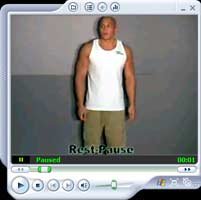 |
View The Video:
Choose your version:
|
 Work Your Legs
Work Your Legs
This sounds obvious but it is surprising how many people I still see at the gyms that don't do legs. Your body grows as a whole so if the upper body is not growing, and you are not doing legs. Start!
Squats are your friend. Doing squats strengthens your core, releases growth hormone and testosterone into your system, and will help you build am impressive set of wheels. Nothing looks funnier than a guy with a big upper body and no legs.
 Learn More About Leg Training...
Learn More About Leg Training...
 Supplements
Supplements
- Supplements are very important. When pushing our body to their limits workout after workout. We need all the help we can get. Here I will list the supplements that I believe are not only crucial in helping avoid a plateau, but are very important for overall health.
Multivitamins are one of the most basic yet important supplements you can take. Hard training drains your body of vitamins and minerals. Taking a good multivitamin is a good insurance policy to make sure the body is getting what it needs.
It is tough to get in all the protein required by our diets in solid foods. Either you don't have the time or you just get sick of eating. That is where Protein Powders and Protein bars come in to play.
Whey Protein is the best for post workout when rapid absorption is important. In addition, Micellar casein is a great slow digesting protein that can take up to 7 hours to be absorbed. It is perfect for taking before going to bed. Remember this is the time when your body is repairing muscles. You want to feed it at this time.
Branched Chain Amino Acids play an important role in many functions. Recovery is one of them so I think they are one of the most important supplements you can take.
Glutamine is another supplement that has proven to be great at shortening the time required to recover from workouts, and is a great addition to any supplement regimen. Especially when you are cutting and trying to maintain your hard earned muscle mass.
I think a lot of people really underestimate how effective Vitamin C is at aiding in recovery. 1 gram 3 times a day not only makes a huge difference in recovery time it also boosts your immune system.
You can't make gains when you're sick in bed. For that reason alone it is well worth making Vitamin C a part of your daily supplement intake.
Creatine Monohydrate Creatine Ethyl Ester and Tri-creatine malate Kre-Alkalyn are all different forms of creatine. Creatine Ethyl Ester and Kre-Alkalyn are the most effective due to the fact that they have a much higher absorption rate than regular creatine monohydrate (up to 30 times higher).
They are very effective and have gotten me through plateaus on their own. No other supplement on the market is as safe and effective as Creatine.
EFAs are a very important part of your diet because they can not be manufactured by your body. EFAs (essential Fatty Acids) help with everything from energy production to helping with arthritis, and reducing water retention.
They also lubricate your joints, and are a natural anti- inflammatory. So make sure you are getting enough either through your diet, or by supplementing with them.
Ok that's it. You are now armed with all the information and tools you'll need to break through plateaus.

2nd Place - antihero

Plateaus are an event that plagues a bodybuilder's life, and as we all know, there is nothing more aggravating than not being able to add mass or weights. Even though plateaus occur quite often, most people do not know how to go about giving their training a kick-start again.
A plateau can occur for various reasons, but no-matter what the reason is (whether from your CNS or your diet) they can be overcome. Here I will outline 10 things that you can do to get past this new plateau.
 1. Review Your Diet/Nutrition
1. Review Your Diet/Nutrition
- Increase your daily protein intake
- Increase daily caloric intake
- Remove all junk food from your diet
- Make sure that you are taking in enough of each vitamin and mineral.
Increasing your protein intake will allow your body to use the protein for rebuilding muscle fibers. Increasing your caloric intake will allow your body to provide you with more energy during workouts.
Removing all the junk food from your diet will remove calories, but those are essentially empty calories that do nothing for you. This is where step b fits in.
Step d is very important because vitamins and minerals are easily depleted when your body is trying to rebuild muscle fibers. Vegetables hold large quantities of these vitamins and minerals, but one or two multi-vitamins will also help (this will be covered more in depth later on).
 2. Switch up your Training Methods
2. Switch up your Training Methods
If the routine you are currently using is a high volume - low frequency, switch to a low volume - high frequency routine.
If you use a customized routine that you developed for yourself, consider rotating exercises every few weeks, even if you haven't yet reached a plateau on that exercise, it may sound crazy, but it will keep your body guessing. Another thing that you can change is the days and body parts you work on.
If you are doing a Monday, Wednesday, Friday split, consider breaking your muscle groups into a 4-day split. Here is a link to the workout database, so that you are able to find whatever kind of routine you are looking for.
 3. Review your Cardiovascular Exercise
3. Review your Cardiovascular Exercise
It is important make sure that you are doing this at the correct times, and that you are also getting the most benefit from your cardio.
 Click Here To Learn More About Cardiovascular Programs.
Click Here To Learn More About Cardiovascular Programs.
 4. Take a Short Vacation
4. Take a Short Vacation
Giving yourself a break for a week or two can be very beneficial for not only your body, but also for your mind. During this time you can catch up with doing things you haven't had time for, while your body repairs itself, and relieves stress.
Something that is often overlooked is the fact that extreme duress can negatively affect the body's ability to repair itself.
 5. Vary Your Reps
5. Vary Your Reps
- Vary the number of reps done per set
- Use supersets
- Use per-exhaustion supersets
- Use cheating reps
- Use forced reps
- Use descending sets
- Uuse burns
- Use negative reps
- Use psycho sets.
Cheating Reps Video Guide:
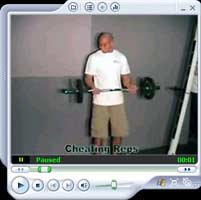 |
View The Video:
Choose your version:
|
Forced Reps Video Guide:
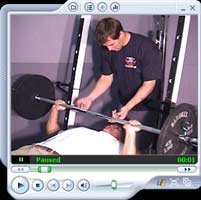 |
View The Video:
Choose your version:
|
 Click Here For An Explanation Of These Techniques.
Click Here For An Explanation Of These Techniques.
 6. Vary Your Time Between Sets
6. Vary Your Time Between Sets
At the end of the three weeks, increase the rest period between the sets back to the 2 minutes that you originally had it at, and I guarantee you'll see an amazing increase in your weights on the exercise, and as we all know, with strength comes size.
 7. Have You Actually Reached A Plateau,
7. Have You Actually Reached A Plateau,
Or Are You Just Overtraining?
Remember that there is a fine line between growth and overtraining, and you must remember to push yourself far enough, but not too far.
 8. Keep Your Focus/Determination
8. Keep Your Focus/Determination
This is where choosing the proper workout partner comes into play. The person needs to be someone who you can talk with easily, and has to be someone who has the same desires as you. However, the two most important features in a workout partner are trust, and motivation.
 Click Here To Learn More About Focus...
Click Here To Learn More About Focus...
You must be able to trust your workout partner in all circumstances, because when you are bench-pressing near your max weight, you cannot afford to have the weight lying on your chest and your partner/spotter laughing at you.
In addition, your workout partner should be a source for motivation, and not a distraction. Having friendly competition between you and your spotter is one way to keep your focus better while in the gym.
 9. Stay Hydrated
9. Stay Hydrated
Keep in mind that drinking large amounts of water all at once is the worst thing you can do. Because, the body will respond to a sudden sharp increase in water by releasing diuretic hormones to excrete as much of the excess water as possible, further dehydrating you.
 10. Consider Supplements
10. Consider Supplements
- - Creatine is a naturally occurring substance found in meats and fish. It is also produced in our bodies by organs such as the liver and kidneys. Creatine allows bigger muscle gains, more energy, and bigger pumps.
The best part about creatine is that it has been around for well over 10 years, and there are still no side effects to taking this supplement.
Creatine Ethyl Ester HCL (CEE) - CEE is a more potent form of monohydrate, simply because its absorption is about 30 times better than that of regular creatine.
Glutamine - Glutamine is the most abundant amino acid in the muscles. The body naturally produces it, but while the body is under intense stress, the production is not increased even though the demand for it is. Increased amounts of glutamine in the body lead to faster muscle recuperation.
Nitric Oxide - Nitric Oxide is a gas that can travel freely through cell membranes. This allows it to increase blood flow, which means that nutrients can be carried to the muscles quicker, and makes it easier to have larger pumps. Nitric Oxide also increases the production of adrenaline.

3rd Place - doggiejoe

 Total Plateau Annihilation
Total Plateau Annihilation
You start to believe you'll never stop growing. You imagine you'll be as big as Ronnie Coleman in a couple of months. Then 2 months later you're stricken with reality. You've stop growing. Reason being: you hit a plateau.
Most beginners think a plateau is a green flat plane. Well it's not. It's a bodybuilder's worse enemy. It is the main reason beginners stop seeing gains and start losing motivation. It's the major cause of why almost everyone quits after 2 months of working out.
Plateaus not only affect beginners, they even hit the stars of bodybuilding. No one wants to hear the P word. Winning the battle against plateaus is what makes your gains keep on coming. In this article I'm going to advise you on the best ways to tackle this evil.
To begin with, take a look at your bodybuilding lifestyle. Is there something wrong with it? Do you have your diet in check? Are you giving your body time to rest? Are you overtraining?
 Eating Habits
Eating Habits
Plan what you're going to eat the whole day and stick to it. Try to get at least 1 gram of protein for every pound you weigh and eating 5-6 meals a day and every 2-3 hours so you won't go into a catabolic state.
In addition you want to keep your muscle cells well hydrated so they are able to grow. The recommended water intake is 1 ounce for every kilogram you weigh.
A celebrated way to go over strength/mass plateaus is to go on a bulking diet. When you go on a bulking diet you want to keep fat gain to minimal. During this time keep your diet as clean as possible while maximizing your calories.
The amount of calories you should consume is your body weight multiplied by 20. This is a great way to put on mass and get over the hump.
 Overtraining
Overtraining
This break can only do you good, and give you a pleasant surprise. If you've been working out consecutively for that long, take a week off, you deserve it. Not only from weight training but any physical activity including cardio! Furthermore you want to keep all your workouts under an hour so you won't overtrain.
Staying hydrated during your workout is also vital, so make sure to take a water bottle with you. After your workout, I recommend to take a warm shower to loosen your muscles and speed up the healing process.
You also want to give each body part at least 48 hours of rest. Most bodybuilders like to give each body part a week off to completely heal. This works because some body parts are getting worked out indirectly on other exercises not intended for it. For example your triceps and shoulders are worked when bench pressing.
One thing everyone should be aware of is that you don't grow while you're working out. So stop staring in the mirror, you're not any bigger. So when do you grow? Healing mostly takes place when you are sleeping!
This is why you should get at least 7-8 hours of sleep a night. Your bedtime meal should also consist of a casein protein because it's slowly digested and best for nighttime.
 Shocking Your Muscles
Shocking Your Muscles
As soon as they adapt to your routine, you stop growing. Muscles don't want to grow they would rather stay undersized and puny, which is the very reason for teaching them who is boss.
After a while your muscles get use to your routine and they are not worked as hard. They learn how to cope with the exercise you do, and even figure out your rep and set range. This is why you need to keep you muscles guessing. By doing so, you're shocking them; to shock your body, you should adjust your routine every 4-6 weeks.
Simple Shocking Methods:
Example: Do incline bench press before flat bench press on chest days.
Example: Say you do 8-10 reps you would switch to 4-6 for more strength/mass or 12-15 for more muscle endurance/definition.
Example: Do hammer curls in place of regular curls. Check out the exercise database for various exercises.
Example: Rest 30 seconds instead of 60 seconds.
Example: Try to go faster or slower than usual when performing certain lifts.
Example: If your chest is noticeably bigger than your back, you should do more back work, so you won't have muscle imbalance.
Example: Go wider or closer on exercises like bench press and barbell curl to work the muscle from different angles.
Example: Use dumbbells to bench press rather than a barbell for more range of motion.
* Utilize all of these methods and change your entire routine.
 Experiment With Something New
Experiment With Something New
What you want to do is explore all the different programs that are out there. Different programs work for different people. So go and find out which is best for you.
Supersets
- Supersets are a magnificent way to astound your muscles with something different. If you've never tried doing supersets before, expect to wake up sore the next morning.
The best type of superset is when you use opposite muscle groups. While one muscle is lifting the other one is resting. For example you could bench press then immediately after do a lat pulldown.
Not only are supersets going to shock your muscles but it's also going to save you time. Your endurance will be tested the first couple of weeks you're on it, so beware. You won't be disappointed with the results.
Dropsets
- Dropsets are beneficial for increasing
- and muscle size. The way to do them is by setting up the weight from smallest to largest (smallest on the inside).
You then have 2 of your friends on each side to strip the weight when you reach failure. For example on the bench press you would pick a weight you can do about 10 times and then little by little have the weight stripped off until only the bar is left. Hopefully no one will be looking when you're struggling with the bar.
Forced Reps
- Forced reps are exactly what they sound like. Say you can do a certain amount of weight for 8 reps and then reach failure.
When you reach failure your spotter will then help you crank up 3 or 4 more reps. This helps you push the limit of failure and once again shocks your muscles into new growth!
Overloading
- If you don't apply more pressure on your muscles, they won't grow. If you stay with the same weight, your muscles will adapt to it and not get any larger or stronger.
For your muscles to get bigger, you have to follow the principle of overloading and demand more of your muscles. By demanding more of your muscles, you have to lift more often and heavier. Therefore, you have to increase resistance, sets, and repetitions.
Plyometrics
- There's no other manner of training that will shock your muscles more than
plyometrics
- . Shocking is the foundation of plyometrics with the main objective being to transform your slow twitch fibers into fast twitch fibers.
Athletes use it to get faster and quicker but you can also use it for these plateaus. One exercise on the bench press would be to let the weight drop from the lockout position then catch it.
This won't only make you stronger, but you will be able to lift the weight even faster. There are many plyometric exercises you can implement into your routine. The dreadful issue about plyometrics is the high risk of injury, so train smartly.
 Learn More About Plyometrics...
Learn More About Plyometrics...
 Additional Aspects Of Conquering Plateaus
Additional Aspects Of Conquering Plateaus
Intensity
- Are you pumped up to lift or do you just go about it as if you were reading a book?
- in the weight room leads to energy. Energy then leads to strength. Strength then helps you lift the weight.
An excellent way to get pumped is by listening to your favorite hardcore song. This will get the juices going and there will be no stopping you.
Your Body

- You already know how to properly feed your body. However, don't turn that around and take some illegal drug and cause damage to your body. You should also kick the habit of smoking, which only hurts your gains.
Excessive alcohol drinking is also damaging for you and your diet. If you're going to drink, drink your protein shake. Treat your body like a holy temple so it's ready to go when it's crunch time.
Mental Barriers
- Is the reason you're facing a plateau, have to do something with your
- ? It might be. You have to have confidence in yourself that you're going to be triumphant. You might be trapped at 220 but just can't get 225.
Why you ask? Not because you're not strong enough physically but because you're not strong enough mentally. Maybe the big plates intimidate you.
You really have to bear down, dig deep down inside of you, and be able to control your mind. When you gain control of your mind, you're easily going to be able to gain control over plateaus.
Record Keeping

- I recommend keeping a workout log for everyone that bodybuilds. Not only should you keep logs of your workout but also of what you eat. The greatest benefit of keeping a log is that you're able to track your progress.
It also allows you to go back to the past and see what worked and what didn't. You should also plan ahead. By planning ahead, I mean for you to construct a routine for the future. This way you're ready to change your routine every 4-6 weeks and know what you're going to do.
Proper Form
- You've come this far, so why would you want to risk it all with bad form? Throw it all out the window with an injury. I understand you want to get over a plateau but using bad form is unacceptable.
You won't get any stronger or any bigger because you're lifting improperly. The only thing you will get is a trip to the hospital. So always remember to stress proper form when lifting. I know you don't want to start from scratch all over again.
Supplements
- Supplements are the last factor to get you over a plateau. This should be the final item on your list. Make sure you have everything else in order foremost. When it comes to supplements make sure you have the 2 fundamental supplements in
- and a
- .
If it's a strength plateau you're facing, the finest supplement to fight is creatine. The best creatine being Creatine Ethyl Ester, commonly known as CEE.
CEE will amaze you and put you over any strength plateau. If you want to grow then your focal point should be on nighttime supplements.
ZMA is a cheap effective supplement that will give you deeper sleep and may raise your testosterone levels. The other nighttime supplement is a casein protein. Casein proteins are essential for nighttime because it's slowly digested and provides an anti-catabolic effect. Remember the better the sleep, the better the gains.
 Final Words
Final Words
So keep things fresh and never stop growing. Now go out there and shock those muscles. Most importantly lift hard, and keep the gains coming!

